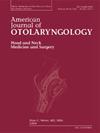Tele-voice therapy. Application of the tele-medicine paradigm to speech therapy for dysphonia: A systematic review
IF 1.7
4区 医学
Q2 OTORHINOLARYNGOLOGY
引用次数: 0
Abstract
Objective
Over the last decades, tele-rehabilitation has been gaining popularity in speech and language disorders. To date, studies on tele-speech therapy have been focused mostly on speech and/or communication disorders. However, only a minority of the available investigations delved into voice disorders. The main aim of this review has been to summarize and critically analyze the available evidence on tele-rehabilitation in voice disorders.
Methods
A search of the English literature was conducted in PubMed, Scopus and Web of Science.
Original reports were included investigating the feasibility and efficacy of tele-speech therapy in human patients with dysphonia and reporting pre- and post-treatment outcomes. Studies with no objective outcomes or a small case series (fewer than 10 participants) were ruled out.
Results
482 articles were retrieved. After duplicates' removal, and title/abstract screening, 20 potentially relevant articles remained. After subsequent full-text screening, only 6 articles were included.
Conclusion
Despite their methodological heterogeneity and small sample size, the available studies seem to support tele-speech therapy as an effective tool for selected dysphonia patients. In particular, remote therapy may be proposed to overcome logistical issues, potentially increasing patients' adherence, especially in case of rehabilitation programs requiring no direct contact or manipulation (e.g. Lee Silverman Voice Treatment for Parkinson's disease). Moreover, hybrid in-person and remote approaches may be proposed as flexible solutions to administer a patient-tailored rehabilitation program, potentially maximizing the benefits of both settings. However, to develop stronger evidence-based practices, large-scale prospective controlled studies are required (preferably in a multi-center setting).
Tele-voice疗法。远程医疗范例在语音障碍言语治疗中的应用:系统回顾
在过去的几十年里,远程康复在言语和语言障碍中越来越受欢迎。迄今为止,远程语言治疗的研究主要集中在语言和/或沟通障碍上。然而,只有少数可用的调查深入到声音障碍。本综述的主要目的是总结和批判性分析语音障碍远程康复的现有证据。方法在PubMed、Scopus和Web of Science中检索英文文献。原始报告包括调查远程语言治疗人类语音障碍患者的可行性和疗效,并报告治疗前后的结果。没有客观结果或小病例系列(少于10名受试者)的研究被排除。结果共检索文献482篇。在删除重复和标题/摘要筛选后,剩下20篇可能相关的文章。在随后的全文筛选后,只有6篇文章被纳入。结论:尽管这些研究方法的异质性和样本量较小,但现有的研究似乎支持远程言语治疗作为一种有效的工具来治疗特定的语音障碍患者。特别是,远程治疗可以克服后勤问题,潜在地增加患者的依从性,特别是在不需要直接接触或操作的康复计划的情况下(例如李西尔弗曼声音治疗帕金森病)。此外,面对面和远程的混合方法可以作为灵活的解决方案来管理为患者量身定制的康复计划,潜在地最大化两种设置的好处。然而,为了发展更强有力的循证实践,需要大规模的前瞻性对照研究(最好是在多中心环境中)。
本文章由计算机程序翻译,如有差异,请以英文原文为准。
求助全文
约1分钟内获得全文
求助全文
来源期刊

American Journal of Otolaryngology
医学-耳鼻喉科学
CiteScore
4.40
自引率
4.00%
发文量
378
审稿时长
41 days
期刊介绍:
Be fully informed about developments in otology, neurotology, audiology, rhinology, allergy, laryngology, speech science, bronchoesophagology, facial plastic surgery, and head and neck surgery. Featured sections include original contributions, grand rounds, current reviews, case reports and socioeconomics.
 求助内容:
求助内容: 应助结果提醒方式:
应助结果提醒方式:


